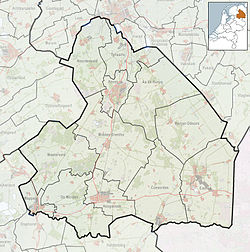Barger-Compascuum
Barger-Compascuum | |
|---|---|
 Saint Joseph Church in Barger-Compascuum | |
Location in province of Drenthe in the Netherlands | |
| Coordinates: 52°45′11″N 7°02′25″E / 52.7531°N 7.0402°E | |
| Country | Netherlands |
| Province | Drenthe |
| Municipality | Emmen |
| Established | 1866 |
| Area | |
| • Total | 25.09 km2 (9.69 sq mi) |
| Elevation | 17 m (56 ft) |
| Population (2021)[1] | |
| • Total | 1,925 |
| • Density | 77/km2 (200/sq mi) |
| Time zone | UTC+1 (CET) |
| • Summer (DST) | UTC+2 (CEST) |
| Postal code | 7884[1] |
| Dialing code | 0591 |
| Website | barger-compascuum.com |
Barger-Compascuum is a village in the Dutch municipality of Emmen. It is in a peat-producing region of Drenthe. Veenpark, an open-air museum, is dedicated to the peat history of the region.
Borger-Compascuum is located in the Bourtange moor between Germany and the Netherlands. It was originally a compascuum (common pasture). In 1866, Barger-Compascuum was established, and the area was permanently inhabited.
Background
[edit]The Bourtange moor, a large raised bog, formed the border between the Netherlands and Germany. It was an inhospitable uninhabited area which was dissected by the Runde River.[3] The shepherds from both Ober- and Niederlangen in Germany and Noord- and Zuidbarge in the Netherlands used the heath for their sheep.[4][3]
There was disagreement about the ownership, and a compascuum (common pasture) was agreed. The shepherds from both sides could use the land, but no permanent settlement was allowed. The compascuum did not solve the problem, and there were several large-scale fights between the Dutch and German farmers. In the 1824 Treaty of Meppen, the border was set, however the compascuum remained in effect until 1866 when permanent settlement was allowed in the moorland.[4][3]
History
[edit]On 23 July 1866,[5] the village of Barger-Compascuum was founded.[6] The first settlers were mainly farmers from Hannover who started to dig the canals, excavate the peat, and plant buckwheat.[7] A linear settlement was built along the canals, and many people lived in sod houses.[4] In 1872, a Catholic church was built, and a parish was established.[8] Between 1923 and 1925, it was replaced with the current church.[7] The systematic cultivation of the area started in the 1910s.[7]
Sights
[edit]In 1966, Veenpark, an open-air museum dedicated to the peat history of the region, was opened.[7] It contains a sod house village, a windmill and a clog factory.[9]
In 1983, the smock mill De Berk was moved to Barger-Compascuum. The mill was originally located in Drantum.[10]
In 2001, a pump organ museum opened in the Veenpark, and contains a collection of 250 pump organs.[11]
Notable people
[edit]- Ben Feringa (born 1951), synthetic organic chemist, 2016 Nobel Prize in Chemistry[12]
- Albert Hermelink Gentiaras (1898–1983), clergyman and bishop of Tanjungkarang[13]
Gallery
[edit]-
Potato starch factory
-
The clog house in Veenpark
-
Pump organ museum
-
Children in the heath with sod houses
References
[edit]- ^ a b c "Kerncijfers wijken en buurten 2021". Central Bureau of Statistics. Retrieved 11 March 2022.
- ^ "Postcodetool for 7884NA". Actueel Hoogtebestand Nederland (in Dutch). Het Waterschapshuis. Retrieved 10 March 2022.
- ^ a b c "Geschiedenis". Barger-compascuum (in Dutch). Retrieved 11 March 2022.
- ^ a b c Leon Bok. "Barger-Compascuum". Dodenakkers (in Dutch). Retrieved 11 March 2022.
- ^ "Compascuum: afschriften van aktes incl. plattegrond 1860-1866 notaris J. Heppener, Provinciale Drentsche en Asser Courant". Collection Broer Berens (in Dutch). Retrieved 11 March 2022.
- ^ "Barger-Compascuum - (geografische naam)". Etymologiebank (in Dutch). Retrieved 11 March 2022.
- ^ a b c d Ronald Stenvert (2001). Barger-Compascuum (in Dutch). Zwolle: Waanders. ISBN 90 400 9454 3. Retrieved 11 March 2022.
- ^ "Barger-Compascuum". Geheugen van Drenthe (in Dutch). Retrieved 11 March 2022.
- ^ "Barger-Compascuum". Plaatsengids (in Dutch). Retrieved 11 March 2022.
- ^ "De Berk". Molen database (in Dutch). Retrieved 11 March 2022.
- ^ "Harmonium Museum Nederland". Harmonium museum (in Dutch). Archived from the original on 14 May 2018. Retrieved 11 March 2022.
- ^ Iris van den Brand. "Ben Feringa (1951): Trouwe Nobelprijswinnaar". De Verhalen van Groningen (in Dutch). Retrieved 11 March 2022.
- ^ "Bijzonder gezin Hermelink in Denekamp". Erfgoed Denekamp (in Dutch). Archived from the original on 4 March 2016. Retrieved 11 March 2022.
External links
[edit] Media related to Barger-Compascuum at Wikimedia Commons
Media related to Barger-Compascuum at Wikimedia Commons- Official website (in Dutch)






